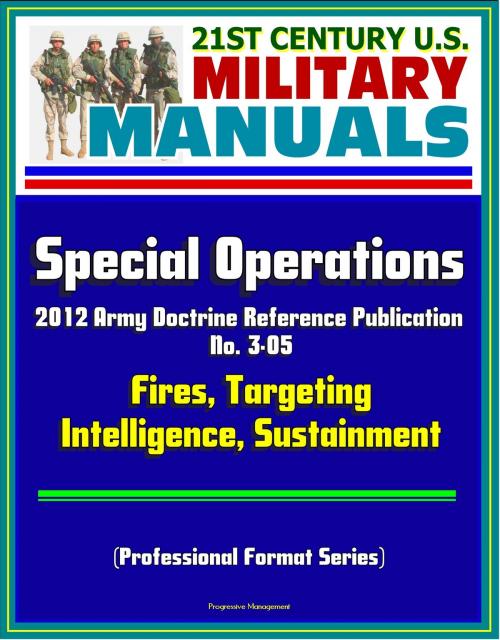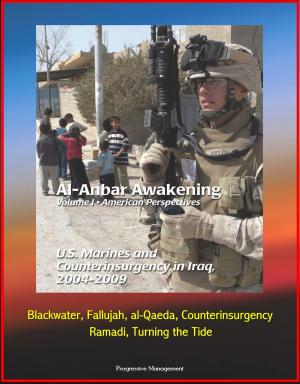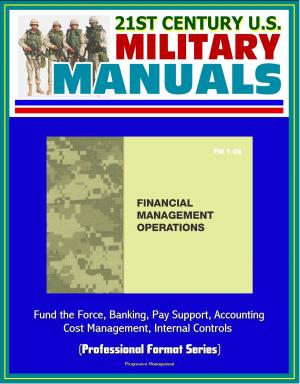21st Century U.S. Military Manuals: Special Operations - 2012 Army Doctrine Reference Publication No. 3-05, Fires, Targeting, Intelligence, Sustainment (Professional Format Series)
Nonfiction, History, Military, Social & Cultural Studies, Political Science| Author: | Progressive Management | ISBN: | 9781301655687 |
| Publisher: | Progressive Management | Publication: | November 28, 2012 |
| Imprint: | Smashwords Edition | Language: | English |
| Author: | Progressive Management |
| ISBN: | 9781301655687 |
| Publisher: | Progressive Management |
| Publication: | November 28, 2012 |
| Imprint: | Smashwords Edition |
| Language: | English |
Professionally converted for accurate flowing-text e-book format reproduction, this Army Doctrine Reference Publication (ADRP) 3-05, Special Operations, provides a broad understanding of Army special operations by describing how executing the two mutually supporting critical capabilities of special warfare and surgical strike contribute to unified land operations. ADRP 3-05 provides a foundation for how the Army meets the joint force commander's needs by appropriate integration of Army special operations forces (ARSOF) and conventional forces.
The principal audience for ADRP 3-05 is all members of the profession of arms. Commanders and staffs of Army headquarters serving as joint task force or multinational headquarters should also refer to applicable joint or multinational doctrine concerning the range of military operations and joint or multinational forces. Trainers and educators throughout the Army will also use this publication.
Commanders, staffs, and subordinates ensure their decisions and actions comply with applicable U.S., international, and, in some cases, host nation laws and regulations. Commanders at all levels ensure their Soldiers operate in accordance with the law of war and the rules of engagement.
Chapter 1 * OVERVIEW OF SPECIAL OPERATIONS * Operational Environments * Support of Global Operations * Strategic Environment * Range of Military Operations * Types of Military Operations * Critical Capabilities * Special Operations Core Principle * Regional Mechanisms * Nature of Special Operations * Army Special Operations Forces Characteristics * Special Operations Operational Mission Criteria * Special Operations Forces Imperatives * Interdependence of Forces * Chapter 2 * CORE OPERATIONS AND ACTIVITIES * Core Operations * Core Activities * Chapter 3 * COMMAND STRUCTURE * Unity of Effort * Theater of Operations Organization * Joint Special Operations Air Component Commander * Liaison and Coordination Elements * Special Operations Communications Support * Operations Structure * United States Special Operations Command * United States Army Special Operations Command * United States Army Special Forces Command (Airborne) * United States Army John F. Kennedy Special Warfare Center and School * Army Special Operations Aviation Command * United States Army Military Information Support Operations Command (Airborne) * Civil Affairs Brigade (Airborne) * Ranger Regiment (Airborne) * Sustainment Brigade (Special Operations) (Airborne) * Chapter 4 * FIRES * Targeting Cycle * Land Component Targeting Process * Joint Fires * Special Operations Feasibility Assessment * Special Operations Forces Joint Fires Element * Inform and Influence Activities * Threat Center of Gravity Analysis * Chapter 5 * INTELLIGENCE * Special Operations Intelligence Criteria * National-Level Intelligence Support * Theater Intelligence * Special Operations Capabilities * Special Operations Intelligence Architecture * Special Operations Unmanned Aircraft Systems * Chapter 6 * SUSTAINMENT * Planning * Special Operations Logistics Support Execution * Army Special Operations Forces Sustainment Structures * Theater of Operations Logistics Considerations * Chapter 7 * PROTECTION * Conduct Personnel Recovery * Implement Operations Security * Employ Safety Techniques * Provide Force Health Protection * Conduct Chemical, Biological, Radiological, and Nuclear Operations * GLOSSARY * REFERENCES
As a bonus, this reproduction includes the complete 2012 Army Leadership manual (FM 6-22), which describes the Army's view of leadership, outlines the levels of leadership (direct, organizational, and strategic), and describes the attributes and core leader competencies across all levels.
Professionally converted for accurate flowing-text e-book format reproduction, this Army Doctrine Reference Publication (ADRP) 3-05, Special Operations, provides a broad understanding of Army special operations by describing how executing the two mutually supporting critical capabilities of special warfare and surgical strike contribute to unified land operations. ADRP 3-05 provides a foundation for how the Army meets the joint force commander's needs by appropriate integration of Army special operations forces (ARSOF) and conventional forces.
The principal audience for ADRP 3-05 is all members of the profession of arms. Commanders and staffs of Army headquarters serving as joint task force or multinational headquarters should also refer to applicable joint or multinational doctrine concerning the range of military operations and joint or multinational forces. Trainers and educators throughout the Army will also use this publication.
Commanders, staffs, and subordinates ensure their decisions and actions comply with applicable U.S., international, and, in some cases, host nation laws and regulations. Commanders at all levels ensure their Soldiers operate in accordance with the law of war and the rules of engagement.
Chapter 1 * OVERVIEW OF SPECIAL OPERATIONS * Operational Environments * Support of Global Operations * Strategic Environment * Range of Military Operations * Types of Military Operations * Critical Capabilities * Special Operations Core Principle * Regional Mechanisms * Nature of Special Operations * Army Special Operations Forces Characteristics * Special Operations Operational Mission Criteria * Special Operations Forces Imperatives * Interdependence of Forces * Chapter 2 * CORE OPERATIONS AND ACTIVITIES * Core Operations * Core Activities * Chapter 3 * COMMAND STRUCTURE * Unity of Effort * Theater of Operations Organization * Joint Special Operations Air Component Commander * Liaison and Coordination Elements * Special Operations Communications Support * Operations Structure * United States Special Operations Command * United States Army Special Operations Command * United States Army Special Forces Command (Airborne) * United States Army John F. Kennedy Special Warfare Center and School * Army Special Operations Aviation Command * United States Army Military Information Support Operations Command (Airborne) * Civil Affairs Brigade (Airborne) * Ranger Regiment (Airborne) * Sustainment Brigade (Special Operations) (Airborne) * Chapter 4 * FIRES * Targeting Cycle * Land Component Targeting Process * Joint Fires * Special Operations Feasibility Assessment * Special Operations Forces Joint Fires Element * Inform and Influence Activities * Threat Center of Gravity Analysis * Chapter 5 * INTELLIGENCE * Special Operations Intelligence Criteria * National-Level Intelligence Support * Theater Intelligence * Special Operations Capabilities * Special Operations Intelligence Architecture * Special Operations Unmanned Aircraft Systems * Chapter 6 * SUSTAINMENT * Planning * Special Operations Logistics Support Execution * Army Special Operations Forces Sustainment Structures * Theater of Operations Logistics Considerations * Chapter 7 * PROTECTION * Conduct Personnel Recovery * Implement Operations Security * Employ Safety Techniques * Provide Force Health Protection * Conduct Chemical, Biological, Radiological, and Nuclear Operations * GLOSSARY * REFERENCES
As a bonus, this reproduction includes the complete 2012 Army Leadership manual (FM 6-22), which describes the Army's view of leadership, outlines the levels of leadership (direct, organizational, and strategic), and describes the attributes and core leader competencies across all levels.















